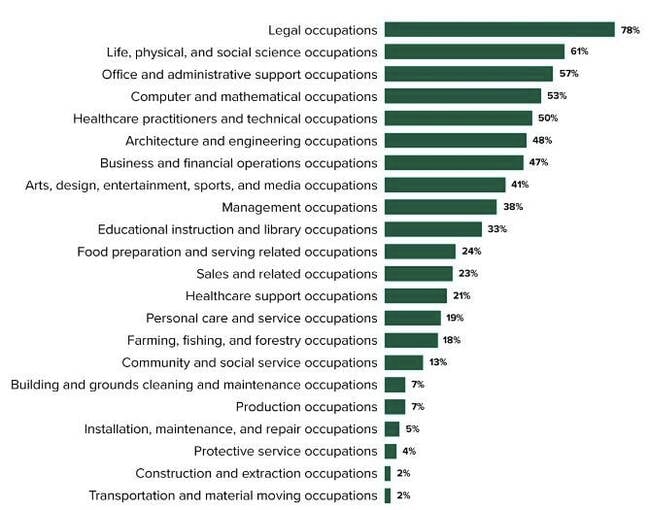Generative AI will replace 2.4 million US jobs by 2030, and influence another eleven million, but other forms of automation will cost more jobs, according to a report from analyst firm Forrester.
The firm’s 2023 Generative AI Jobs Impact Forecast [PDF] predicts that the tech will reshape more jobs than it replaces, but also includes a section titled “Let’s Be Clear: Generative AI Is Coming After White Collar Jobs”.
White collar workers most at risk of being left behind will be technical writers, social science research assistants, proofreaders, copywriters, and those in administrative positions.
The biggest disruptions will be felt by workers that have college degrees, perform white-collar jobs, and are middle class. People with annual salaries less than $60,000, for example, will be impacted less by generative AI than those that earn $90,000 or more. Here’s a chart below showing how much different types of jobs can expect to be influenced by technology:

Such workers have a couple of years in which to prepare, Forrester’s analysts suggest, because its modelling assumes it will take time for “questions on intellectual property rights, copyright, plagiarism, model refresh rates, model bias, ethics, and model response reliability” to be resolved.
The report also predicts that while generative AI will cost jobs, other forms of automation will have a greater impact. In 2023, the report predicts, generative AI will cause 9.3 percent of jobs lost to automation, rising to 30.4 percent by 2030.
Not every job replaced by automation is a job lost to humans, the report asserts, because humans don’t want certain jobs.
“In some cases, automation will stand in for jobs that have been hard to fill,” the report states. “For instance, physical robotics and automation are only beginning to fill the workforce gaps that have plagued frontline work in the 2020s.”
But other jobs will impact humans and Forrester’s analysts warn of “deep social challenges like those faced in the post-industrial Rust Belt.”
Creative types: meet your robot assistant
Forrester’s analysts reckon that workers in more creative industries, like editors, writers, authors and poets, and lyricists, are more likely to incorporate generative AI tools in their jobs and are less likely to be replaced.
Forrester urged leaders to figure out how to use generative AI in a way that will boost worker productivity and improve customer outcomes, and outlined a few roadblocks that might stand in the way.
Despite the technology’s potential, it may actually lead to poor performance. Analysts highlighted that tools like ChatGPT can generate “coherent nonsense” that could lead to inconsistent customer service or lead to workers having to fix issues.
There will also be a gap in people’s skills. “[Companies will] need to hire new, potentially scarce, and expensive talent — developers, business analysts, prompt engineers, even ethicists. The market for this talent will be tight. On the other side, you might lose valuable legacy talent if the pace of change is too fast,” they warned.
In some cases, automating some tasks could lead to substandard outcomes but companies might be pressured to stick with AI anyway. To incorporate generative AI in operations smoothly, companies should analyze which jobs would benefit the most from automation and train employees to learn new skills like prompt engineering, a technique that involves refining input prompts to software with the goal of obtaining specific outcomes.
“[Enterprises] won’t be able to plan for every contingency, but [they] can build a workforce generative AI strategy that better prepares [them] for the Wild West of generative AI at work. [Their] strategy should include investments, guardrails, and checkpoints,” the report concluded.
The Register has asked Forrester for more comment. ®
- SEO Powered Content & PR Distribution. Get Amplified Today.
- PlatoData.Network Vertical Generative Ai. Empower Yourself. Access Here.
- PlatoAiStream. Web3 Intelligence. Knowledge Amplified. Access Here.
- PlatoESG. Automotive / EVs, Carbon, CleanTech, Energy, Environment, Solar, Waste Management. Access Here.
- PlatoHealth. Biotech and Clinical Trials Intelligence. Access Here.
- ChartPrime. Elevate your Trading Game with ChartPrime. Access Here.
- BlockOffsets. Modernizing Environmental Offset Ownership. Access Here.
- Source: https://go.theregister.com/feed/www.theregister.com/2023/09/06/generative_ai_jobs_forrester_report/



